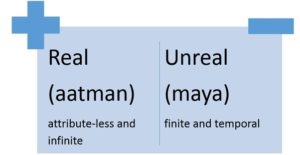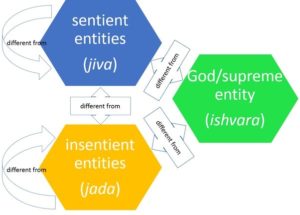Visistadvaita and Advaita
Visistadvaita and Advaita
Q) Discuss the differences between Visistadvaita and Advaita
- The difference between the 2 lies in the definition and nature of Reality as understood by each of these schools
- Ever since the Vedas and Puranas, self-realization has been a fundamental concept in Hindu scriptures. The differences in the interpretation and understanding of Reality, 'I' and the means to Real-I-zation are central to the distinction between these schools of philosophy, that formed around the concepts purported by these scriptures
Advaita:
Reality - Any entity which is finite, temporal or can be defined using attributes is treated as unreal and the spirit (aatman) is supposed to be the only real entity. The spirit is attribute-less and infinite by definition. Any entity outside the realm of the spirit is Maya (unreal, finite, temporal and illusory).
The means to realization - Is to understand this real nature of the spirit and the unreal nature of the material-world. With practice (yoga) and consciousness, the goal of life should be to become one with this reality of Brahman/Aatman. Such a person is supposed to be jivanmukta or liberated from the cycles of birth and death.
As you can see, this is a very binary view of reality. Things are either real or unreal. If you can experience reality and be one with it, you are liberated, else you are under bondage. While the school does believe in worship of God, the conceptualization of God is primarily an abstraction created to act as a North Star to help imagine and understand the otherwise inconceivable, attribute-less, infinite spirit. Hence, ritualistic worship and discussions on the superiority of one God over another are generally considered redundant.
Dvaita:
Reality - The dvaita philosophy classifies reality into three parts, each different from the other. These are - sentient entities, insentient entities and God or the Supreme entity. Each of these is considered to be real. While some may be temporary and others eternal, they are each still very real. Each sentient entity is supposed to be different from another and so is each insentient entity from another insentient entity. The five types of differences are shown below:

The means to realization - is to understand and experience this reality in its fullness and analyze and understand these five types of differences between real entities. Realization is attained and liberation is achieved, when by yoga and actions the soul is able to purify itself and be one with God and God accepts the soul in It's abode. Liberation achieves freedom from birth and death but even in the heavenly abode the gradation of souls still persists.
Since the Dvaita school believes in purification of the soul by actions and treats God as a distinct real entity, the means to attain realization are more akin to Karma Yoga (the path of action) or Bhakti Yoga (the path of devotional service) as opposed to Jnana yoga (the path of knowledge / meditation) which is more in tune with the Advaita school. While Dvaita emphasizes the differences and plurality among entities and lays downs a gradation and heiarchy, Advaita emphasizes the unity in all reality.
Visishtadvaita:
The school recognizes the distinction of entities as proposed by the Dvaita school. However, it also believes that these entities (including the sentient and insentient ones) are nothing but different modes of Brahman (the one true reality). The school therefore upholds both unity and plurality at the same time
ADDITIONAL READING:
ADVAITA:
- "Advaita" literally means "not two", and is often called a monistic or non-dualistic system of thought.
- The word Advaita essentially refers to the identity of the Self (Atman) and the whole (Brahman).
- The key source texts for all schools of Vedānta are the Upanishads (twelve or thirteen major texts, with many more minor texts), the Bhagavad Gītā, which is part of the Mahabhārata, and the Brahma Sūtras (also known as Vedānta Sūtras), which systematize the doctrines taught in the Upanishads and the Gītā.
DVAITA:
- Dvaita Philosophy is an outshoot of the Vedanta Philosophy of ancient India
- Dvaita (meaning dualism) Philosophy was propounded by Madhwacharya in the 13th century
- Dvaita Philosophy proclaims that God and souls are different entities
- Dvaita Philosophy is opposed to the Advaita Philosophy of Shankaracharya which believes in Monism (Non-dualism).
- According to dvaita philosophy, souls are eternal but are not created by God
- The souls are dependent on Vishnu and co-exist with Him eternally, supported by His will and entirely controlled by Him
- Madhwacharya's doctrine differed significantly from traditional Hindu beliefs in the concept of eternal damnation
- To him, souls belong to three classes, one class which qualify for liberation, Mukti-yogyas, another subject to eternal rebirth or eternally transmigrating due to samsara, Nitya- samsarins, and a class that is eventually condemned to eternal hell or Naraka, known as Tamo-yogyas.
- No other Hindu philosopher or group of Hinduism maintains such beliefs since it is accepted that souls will eventually obtain moksha, eventhough it may be after millions of rebirths.
Visishta Advaita:
- The Absolute Supreme Reality referred to as Brahman, is a Transcendent Personality with infinite superlative He is Lord Vishnu, also known as Narayana.
- He creates the other two members of the Trimurti, namely, Creator Brahma and Shiva, the Lord of Deluge
- Narayana is the Absolute God. The Soul and the Universe are only parts of this Absolute and hence, Vishishtadvaita is panentheistic
- The relationship of God to the Soul and the Universe is like the relationship of the Soul of Man to the body of Man. Individual souls are only parts of Brahman.
- God, Soul and Universe together form an inseparable unity which is one and has no This is the non-duality part.
- Matter and Souls inhere in that Ultimate Reality as attributes to a substance. This is the qualification part of the non-duality.
- Souls and Matter are only the body of God. Creation is a real act of God. It is the expansion of Matter is fundamentally real and undergoes real revelation. The Soul is a higher mode than Matter, because it is conscious. It is also eternally real and eternally distinct.
- Final release, that comes, by the Lord's Grace, after the death of the body is a Communion with God.
- This philosophy believes in liberation through one's Karmas (actions) in accordiance with the Vedas, the Varna (caste or class) system and the four Ashramas (stages of life), along with intense devotion to Vishnu
- Individual Souls retain their separate identities even after moksha
- They live in Fellowship with God either serving Him or meditating on Him
- The philosophy of this school is SriVaishnavism, a branch of Vaishnavism

